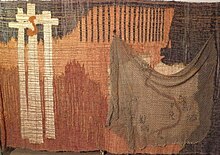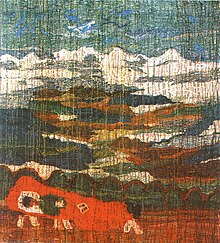Urszula Kolaczkowska
hideThis article has multiple issues. Please help or discuss these issues on the talk page. (Learn how and when to remove these template messages)
|
Urszula Kolaczkowska (pl. Kołaczkowska) | |
|---|---|
 Urszula Kołaczkowska at her studio in Zakopane | |
| Born | 4 October 1911 |
| Died | 29 December 2009 |
| Nationality | Polish |
| Known for | painting, textile arts, tapestry |
Notable work |
|



Urszula Kołaczkowska (4 October 1911 - 29 December 2009) was a Polish fine artist who specialized in hand weaving and textile arts.
Biography[]
She was the daughter of Zofia nee Słonczyńska (1872–1953) and Edward Kołaczkowski (born on 18 November 1849 in Suchodoły, died on 12 August 1933 in Lublin), a landowner, citizen of Lublin city, member of the Lublin City Council and Mayor of Lublin in 1915.
In 1915, Zofia moved with her daughter to Zakopane, where she provided Urszula with her early education at home. Urszula later attended Ładysław of Gielniowo High School, a private school situated on Nowotarska St. in Zakopane, from 1924 to 1931. The director of this school was Fr. Jan Humpola (1889-1958), a well-known mountaineer, and later a chaplain of Ignacy Mościcki, the president of the Republic of Poland. From an early age, Urszula showed interest in arts and sports. Influenced by her mother, who conducted private music courses (including to Teresa Wellely-Mackiewicz), she devoted most of her time to music and made her own attempts at composition. She also drew and painted. From her childhood years she loved mountain hiking and skiing, and her love of the outdoors prompted her to start rowing while at university.
Between 1931 and 1937, Kołaczkowska studied history at the University of Warsaw. Her master’s thesis was on “Territorial Development of Warsaw around the Lubomirski Embankment”, written under the supervision of professor Stanisław Arnold, and on 12 October 1937, she was awarded a master's degree in history. While studying history, she started a course at the School for Journalists in Warsaw, where she earned a diploma after presenting her thesis "The French press during the Great Revolution". Between 1938 and 1939, Kołaczkowska worked as a head of sports column at Bluszcz (Ivy), a weekly magazine for women. During that time, she continued to be an active member of the Warsaw Rowing Society. She spent the Second World War and the occupation in Zakopane. After that, between 1947 and 1948, she attended Podhale State Industrial School for Females in Zakopane, where she learned to weave. She completed her studies with a master’s exam in the art of weaving and wall-hanging art on 25 June 1948.
In 1952, Kołaczkowska was admitted to the Association of Polish Artists and Designers based on the quality of her works. In the same year she had her first exhibition at the first Country-Wide Exhibition of Interior Design and Decorative Art at the Zachęta Art Gallery in Warsaw during May, June and July. Between 1952 and 2004, her works were shown at several dozen national and international exhibitions. Eight years after her first exhibition, in 1960, Kołaczkowska had her first individual exhibition at the Tatra Museum in Zakopane.
Artistic activity[]
Urszula Kołaczkowska was principally a hand weaver who used various material (wool, sisal, flax, hemp, nylon, steel, wood, etc.) and her own, original weaving techniques. Throughout her creative life, she introduced new forms and themes inspired by a mix of Polish and biblical influences: mountains, nature, architecture, fiction, everyday life, history and the ancient times, etc. Her art was not limited to weaving, but also extended into drawing and painting and eventually on to glass and collages. Her works were well praised and held in high esteem. She was awarded, among others, the Nowy Sącz Governor award in 1991 and the Agnieszka Stankiewicz Award in 1998.
Urszula Kołaczkowska remained active, working and creating, until old age. Her artistic legacy is immense and her works can be found among numerous public collections (i.e. the National Museum, Warsaw, Central Museum of Textiles, Łódź, The Tatra Museum in Zakopane, Craft Museum in Krosno) as well as private ones, both in Poland and abroad. Kołaczkowska authored the book ‘500 Questions about the History of Art’ (Warsaw) issued in 1962, with several later editions. She also dabbled in writing fiction, resulting in a criminal novel „Symphonic Etude” [Polish „Etiuda Symfoniczna”] written in the 1960s but published only in 2011. She returned to writing at the end of her life, leaving behind an unfinished criminal novel manuscript.
Until well into her elderly age, she was a keen hiker and cross-country skier. She remained a celebrity in Zakopane, not only among the artistic circles. Short and slightly-built, she was full of life and humor. She surrounded herself with friends of all ages. Last years of Kołaczkowska’s life were saved into photos by the photographer Anna Łodziak. In 2006, her pictures were presented in the Municipal Art Gallery in Zakopane (former Art Exhibitions Bureau Gallery). Urszula Kołaczkowska was laid to rest next to her mother in a new cemetery on Nowotarska St. in Zakopane.
Individual exhibitions[]
1960 – Tapestries and glass paintings (Tatra Museum, Zakopane)
1963 – Tapestries and glass paintings (International Press and Books Club, Zakopane)
1964 – Tapestries and drawings (Pegaz Gallery, Zakopane)
1965 - Tapestries and drawings ( Fine Artist House, Cracow)
1066 - Tapestries and drawings (Desa Gallery, Warsaw)
1970 – Tapestries (Desa Gallery, Cracow)
1971 – Tapestries (Art Exhibitions Bureau Gallery, Nowy Sącz)
1972 – Three series (Art Exhibitions Bureau Gallery, Zakopane)
1975 – Armour and Tugs: tapestries and assemblage (International Press and Books Club, Zakopane)
1975 – Fabric (Art Exhibitions Bureau Gallery, Myślenice)
1975 – Fabric (Art Exhibitions Bureau Gallery, Łódź)
1976 – Fabric (Art Exhibitions Bureau Gallery, Białystok)
1978 – Fabric (Pryzmat Gallery, Cracow)
1979 – Tapestries (Kasprowy Gallery, Zakopane)
1981 – Portraits of Architecture (Art Exhibitions Bureau Gallery, Gorzów Wielkopolski)
1982 – Brezhnev’s Doctrine (the artist’s studio in Zakopane)
1986 – Bible Stories (the artist’s studio in Zakopane)
1987 – Cathedrals and the Bible (Art Exhibitions Bureau Gallery, Gorzów Wielkopolski)
1990 – Travels (Galeria Awangarda, Wrocław)
1991 – Mountain Towns (Art Exhibitions Bureau Gallery, Zakopane)
1992 – Bible Stories (Hadar Gallery, Cracow) (together with Katarzyna Boruch)
1993 – Tents (Jatki Gallery, Nowy Targ)
1995 – My Landscapes (Art Exhibitions Bureau Gallery, Zamość)
1995 – Come in, please (Art Exhibitions Bureau Gallery, Zakopane) (together with Małgorzata Buczek)
1996 – Still Life and other fabrics (Pokaz Gallery, Warsaw)
1997 – Figures and Landscapes (U Jaxy Gallery, Miechów)
1998 – Muses and Water (Zielona Gallery, Busko-Zdrój)
1998 – Interpretations (Archaeological Museum of Kraków, Cracow)
1998 – Everyday Life of Artists in Communist Poland and in the 3rd Republic (Centrum Gallery, Kamienna Góra)
2000 – Fabrics (Pegaz Gallery, Zakopane)
2000 – Kitchen and the Surroundings: fabrics (Kordegarda Gallery - branch of Zachęta, Warsaw)
2003 – Fabrics (Central Museum of Textiles, Łódź)
2012 – Fabrics (Municipal Art Gallery, Zakopane)
2012 - Fabrics and Other Hobbies (Industrial History Museum, Opatówek)
2013 – Artistic Fabric (Służewiec Cultural Centre, Warsaw)
2013 - Fabrics (Stara Prochownia, Warsaw)
2016 – Artistic Creations of Urszula Kołaczkowska (Museum of Mazovian Nobility, Ciechanów)
Participation in exhibitions abroad[]
1965 - Moderne Polsk Billedvev (Kunstindustrimuseet, Norwegian Museum of Decorative Arts and Design, Oslo)
1965 – Moderne Polsk Billedvaevning (Kunstindustrimuseet, Danish Museum of Art & Design, Copenhagen)
1965 – Wandteppiche aus Polen (Leipzig)
1965 – Soudobé Polske Tapiserie (Uměleckoprůmyslového museum, Museum of Decorative Arts in Prague)
1966 – Polnische Gewebe (Galerie in der Biberstrasse, Vienna, Austria)
1969 – Esposizione – mercato internationale di disegni per l’industria tessile (Palazzo delle Esposizioni, Busto Arsizio, Italy)
1979 – Modern Konst från Krakow (Karlshamn, Sölvesborg, Karlskrona, Sweden)
1980 – Exposition de la tapiserie polonaise (Galerie Gilbert Delahaye Cordes, France)
1983 – 2e Plein-Air Franco-Polonais de Tapisserie: “Wibracje”’83 (Galerie Gilbert Delahaye Cordes, France)
1983 – Zakopane Kunst (Asher, Norway)
1983 – Exposition de la tapisserie polonaise (Galerie Banque Albi, France)
1984 – Das Experimentelle Kuenstlerische Geweb (Schloss Rochlitz, near Leipzig)
1987 – Poolse Textiele - en Weefkunst (Allersmaborg, Ezinge; Fransum, Netherlands)
1988 – Consument Art’88 (Messezentrum Nuremberg, Germany)
1992 – Tapisserie Contemporaine de Zakopane (Saint-Dié-des-Vosges, France)
1992 – Zakopane Kunst (Siegen, Germany)
1996 – Internationales Mail Art Project Johannes Kepler (Wendelinskapelle, Weil der Stadt, Germany)
2000 – Urszula Kolaczkowska, Fiber Art; Karol Gąsienica Szostak, Sculpture (Anya Tish Gallery, Houston, Texas, USA)
Bibliography[]
- Archiwum Uniwersytetu Warszawskiego w Warszawie, Album Studentów nr 37657.
- Urszula Kołaczkowska, ’’500 zagadek z historii sztuki’’, Ed. Wydawnictwo: Wiedza Powszechna, 1962 and later editions
- Tadeusz Z. Epsztein, Historia mojej rodziny, w: Społeczeństwo polskie XVIII i XIX wieku, pod red. J. Leskiewiczowej, t. IX, Warszawa 1991, s. 261-346.
- M. Gutowski, Gobeliny i rysunki Kołaczkowskiej, w: „Dziennik Polski” z 31.10-1.11.1965 r., s. 5.
- „Gazeta Wyborcza” (dodatek „Gazeta Stołeczna”) z 20-21.07.1996, s. 16.
- Urszula Kołaczkowska. Kuchnia i okolice: tkanina, lipiec – sierpień 2000 Galeria Kordegarda Warszawa, Krakowskie Przedmieście 15/17, Warszawa 2000.
- „Gazeta Krakowska”, z 6.04.2000 r., s. 5.
- G. Mróz, Tkane obrazy, w: „Tygodnik Podhalański”, z 16.04.2000, s. 13.
- Urszula Kołaczkowska: tkanina: kwiecień-maj 2003 [wystawa Centralne Muzeum Włókiennictwa], Łódź 2003.
- Urszula Kołaczkowska, ’’Etiuda symfoniczna’’, Wydawnictwo Cursor, Warszawa 2011, ISBN 8363086010
- Tadeusz Epsztein, Wrona Zakopiańska, Wydawnictwo Adam, Warszawa 2012
- J. Flach, Kobieta renesansu, w: "Tygodnik Podhalański", z 6.06.2012, s. 32
References[]
- 1911 births
- 2009 deaths
- 20th-century Polish artists
- Polish women artists
- People from Lublin
- 20th-century Polish women